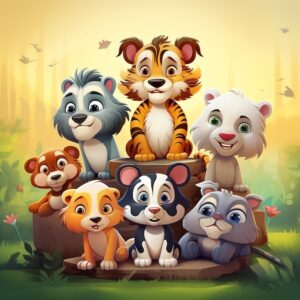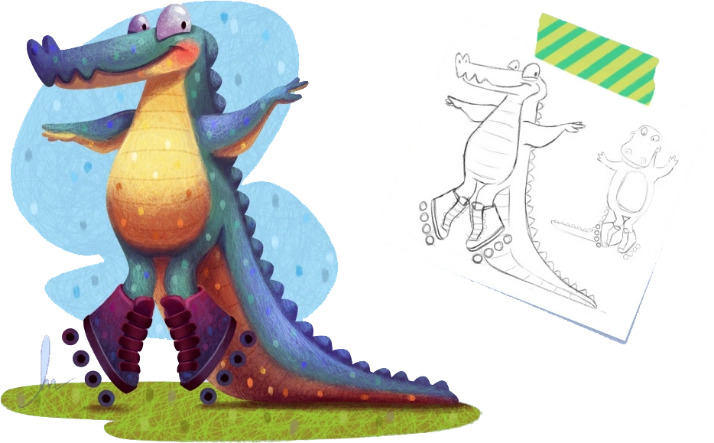Ever tried sketching a lion and ended up with something that looks more like an angry cat? Don’t worry, every great illustrator started there. Learning animal illustration does not revolve solely around mastering anatomy, but also around understanding movement, emotion, and personality.
The beauty of animal illustration lies in its versatility. You can go realistic or abstract, detailed or minimalist. Every line tells a story. And as you start to notice the tiny nuances, your drawings begin to feel alive, like a fox’s fur bending in motion or a bird’s wings folding mid-flight.
Ready to bring your favourite creatures to paper? Let’s explore five simple yet powerful ways to learn animal illustration that will help you sketch with confidence and create art that feels natural, expressive, and uniquely yours.
From Sketches To Storybooks
If your dream is to bring adorable animals to life in children’s books and become one of those great animal illustration artists UK, learning illustration becomes even more interesting. Here, every creature you draw is not just an animal, but a character with a story to tell.
- A rabbit is not just hopping, but off to an adventure.
- A bear is not only roaring, but teaching courage or kindness.
That is the beauty of children’s book illustration. It lets you blend art with storytelling.
To start, focus on personality over perfection. Kids connect more with expressive faces and playful poses than with perfectly realistic drawings.
Exaggerate emotions, experiment with colours, and let your imagination wander. Whether your elephant wears glasses or your penguin rides a skateboard, it is all about making young readers smile and feel the adventure.

- Start with observation
Before your pencil even touches the paper, start by observing. Watch how animals move, eat, or rest in real-life videos or even documentaries.
Notice how a cat arches its back when it is curious or how a giraffe’s long neck bends so gracefully.
These details give your drawings personality and believability. Try keeping a sketchbook where you quickly capture shapes and poses.
The goal is not perfection, but learning how animals behave so your illustrations feel alive and expressive.
- Break it down into simple shapes
Every animal, no matter how complex, starts with basic shapes. A bear can begin as a circle with smaller ovals for limbs, a bird starts as a triangle, and a few curves.
When you simplify animals into shapes, you train your mind to understand their structure. This trick also helps you maintain proportions, especially useful for creating consistent characters in a storybook.
Once you have got the shapes right, you can layer in fur, feathers, and facial expressions.
- Experiment with different styles
There is no single way to illustrate animals for children’s books. Some artists love soft watercolour tones, while others lean toward bold, graphic designs.
Try digital and traditional mediums to find your comfort zone. If you are using Procreate or Adobe Fresco, play with textured brushes that mimic crayon or watercolour effects.
Or go old-school, grab colour pencils and experiment with blending and layering. The more you explore, the faster you will discover a style that feels authentically you.
- Learn the pros
Study the works of children’s book illustrators who bring animals to life with heart.
- Notice how Beatrix Potter gave Peter Rabbit charm through tiny details.
- Or how modern children’s illustrators in UK, like Jon Klassen, use minimalist expressions to convey entire emotions.
Read picture books, not just for the story, but for the art. Notice how colour palettes shift, how animals interact, and how each illustration guides the reader through the narrative.
- Create your own animal characters
Once you have built confidence, it is time to invent your own animal world. Mix traits, play with exaggeration.
- Maybe your lion wears a bow tie
- Or your mouse is the bravest explorer in town.
Give the personalities, quirks, and emotions that children can relate to. Start with short stories or scenes.
- A puppy’s first day at school.
- A shy turtle learning to dance.
Sketch how each moment unfolds. The more you draw from imagination, the more unique your illustration voice becomes.
Types of Illustrations
| Type of Illustration | Description | Best For | Vibe / Style |
| Traditional Illustration | Created using hand-drawn tools like pencils, watercolour, ink, or pastels. | Classic storybooks, warm and emotional tales. | · Soft,
· organic, · nostalgic. |
| Digital Illustration | Made using digital tools
(Procreate, Illustrator, and Photoshop). |
Modern books, bold and vibrant stories. | · Clean,
· colorful, · Flexible. |
| Mixed Media Illustration | Combines traditional sketches with digital colouring or textures. | Playful stories need both warmth and precision. | · Balanced,
· Artistic, · Textured. |
| Vector Illustration | Uses geometric shapes and flat colours, scalable without loss of quality. | Educational books, alphabet, or concept stories. | · Crisp,
· modern, · Structured. |
| Minimalist Illustration | Focuses on simple lines and a few colours to express emotions. | Books for toddlers and early readers. | · Simple,
· charming, expressive. |
| Collage Illustration | Made by layering paper textures, cutouts, and patterns. | Whimsical, creative stories full of personality. | · Textured,
· crafty, · playful. |
Frequently Asked Questions
- Do I need to be good at drawing to start animal illustration
Not at all! You just need curiosity and consistency. Start with simple shapes, practice daily, and observe animals closely. The more you draw, the more confident and natural your strokes will become.
- Which tools are best for beginners in children’s book illustration?
Start simple. A sketchbook, pencils, erasers, and colored pencils or watercolour paints. If you’re going digital, apps like Procreate and Adobe Fresco are user-friendly and beginner-friendly.
- How can I make my animal characters more expressive?
Focus on their eyes, body language, and small details, like how they stand, move, or react. Try exaggerating emotions a bit. Kids love seeing animals that laugh, pout, or look surprised!
Conclusion
Learning animal illustration, especially for children’s books, is about storytelling through art. Every sketch, colour choice, and expression adds emotion and meaning to your characters. The beauty lies in the small details. A smile that tells courage, a pawprint that hints at curiosity, or a gentle glance that says home. As you explore different illustration styles and techniques, remember to enjoy the process. The best artists are not the ones who draw perfectly, but the ones who draw with heart.
So grab your pencils or tablet, let your imagination run wild, and start bringing those adorable animal tales to life one whisker, feather, or wagging tail at a time.








Leave a Reply